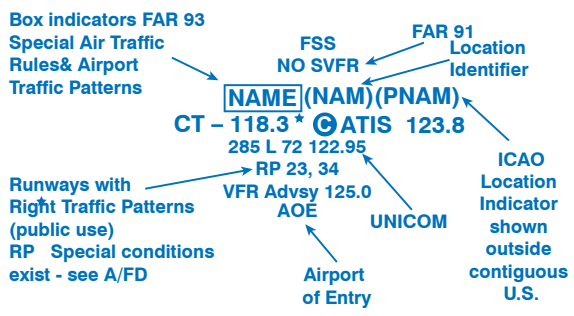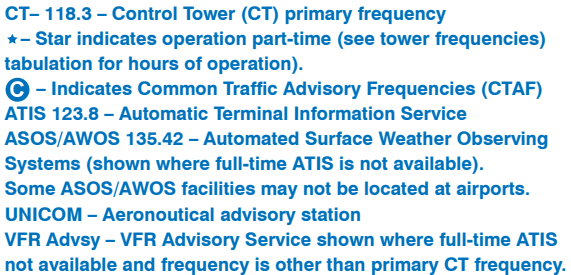Radio communications are an important aspect for the safe operation of aircraft in the NAS. It is
through radio communications that pilots give and receive information before, during and at the
conclusion of a flight.
Although small UA pilots are not expected to communicate over radio frequencies, it is important for the UA pilot to understand “aviation language” and the different conversations they will encounter if the UA pilot is using a radio to aid them in situational awareness when operating in the NAS. Although much of the information provided here is geared toward manned aircraft pilots, the UA pilot needs to understand the unique way information is exchanged in the NAS.
Here is an example of the radio frequency information on the Legend in the Testing Supplement:


The key to communications at an airport without an operating control tower is selection of the correct common frequency. The acronym CTAF, which stands for Common Traffic Advisory Frequency, is synonymous with this program. A CTAF is a frequency designated for the purpose of carrying out airport advisory practices while operating to or from an airport without an operating control tower. The CTAF may be a UNICOM, MULTICOM, FSS, or tower frequency and is identified in appropriate aeronautical publications.
Communication/Broadcast Procedures
A MULTICOM frequency of 122.9 will be used at an airport that is non-towered and does not have a
FSS or UNICOM.
Although a remote pilot-in-command is not required to communicate with manned aircraft when in
the vicinity of a non-towered airport, safety in the National Airspace System requires that remote
pilots are familiar with traffic patterns, radio procedures, and radio phraseology.
When a remote pilot plans to operate close to a non-towered airport, the first step in radio procedures is to identify the appropriate frequencies. Most non-towered airports will have a UNICOM frequency, which is usually 122.8; however, you should always check the Chart Supplements U.S. or sectional chart for the correct frequency. This frequency can vary when there are a large number of non-towered airports in the area.
For non-towered airports that do not have a UNICOM
or any other frequency listed, the MULTICOM frequency of 122.9 will be used. These frequencies
can be found on a sectional chart by the airport or in the Chart Supplements publication from the
FAA.
Take a quick listen to some of the higher traffic airports here: http://www.liveatc.net/topfeeds.php
For safety reasons, a remote pilot must always scan the area where they are operating a small UA. This is especially important around an airport. While it is good operating procedures for manned aircraft to make radio broadcasts in the vicinity of a non-towered airport, by regulation, it is not mandatory. For this reason, a remote pilot must always look for other aircraft in the area, and use a radio for an extra layer of situational awareness
To close, a remote pilot is not expected to communicate with other aircraft in the vicinity of an airport, and should not do so unless there is an emergency situation. However, in the interest of safety in the NAS, it is important that a remote pilot understands the aviation language and the types of aircraft that can be operating in the same area as a small UA
CT - Control Tower primary frequency
Air traffic control (ATC) is a service provided by ground-based controllers who direct aircraft on the ground and through controlled airspace, and can provide advisory services to aircraft in non-controlled airspace.
For Airport Operations without an Operating Control Tower
CTAF - Common Traffic Advisory Frequency
Is frequency designated for the purpose of carrying out airport advisory practices while operating to or from an airport without an operating control tower. This is designated by with a "C" inscribed in a circle on the sectional chart.
When no ATC is available (no tower, or tower closed), the CTAF is used by pilots to advise other pilots of their actions and intentions.
The CTAF is usually transmitted over a UNICOM frequency.
ATIS - Automatic Terminal Information Service
Is a continuous broadcast of recorded noncontrol aeronautical information in busier terminal (i.e. airport) areas.
ATIS broadcasts contain essential information, such as weather information, which runways are active, available approaches, and any other information required by the pilots, such as important NOTAMs.
ASOS/AWOS - Automated Surface Weather Observing Systems
Automated airport weather stations are automated sensor suites which are designed to serve aviation and meteorological observing needs for safe and efficient aviation operations, weather forecasting and climatology.
Some ASOS/AWOS facilities may not be located at airports.